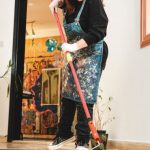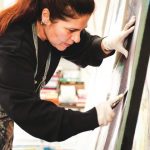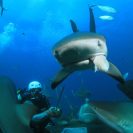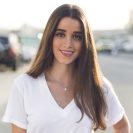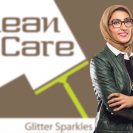While modern artists are constantly in the public eye, Amira Behbehani prefers to remain in the background. Creating her art in peace, the artist finds that keeping a low profile suits her more. As the creative community celebrated her latest solo exhibition at Kuwait’s CAP Gallery that marks her fifteen-year journey with art, we spent one morning with Amira at her studio to explore her inspirations, passions, and what it takes to create art.
Aside from her art which has put her in the spotlight, we learned that the causes and charities that Amira is a part of sparked her interest to become more vocal in the public scene. Amira has found herself creating fundraisers and supporting the Hayatt Breast Cancer Foundation, Peace One Day Charity, LOYAC, several animal shelters and charities, KCRS (Kuwait Child’s Rights Society) and Abolish 153: “I can’t say no to something I believe in,” she started. And as a founding member of Abolish 153, Amira and Sheikha Al Nafisi will be organizing a fundraising art event to raise awareness and funds.
“Alanoud [Alsharekh] and Sheikha Lulu [Al Sabah] called everyone they know,” Amira recalled, “I remember we met in Sheikha Lulu’s house and they asked us if we knew anything about Article 153 – we didn’t. When they asked us if we were interested in being members in their organization, I couldn’t say no. I really believed in the cause and I blindly said yes to joining, even though I need to be trained in the laws to be capable to answer any questions about it.” If it’s not a charity, then Amira’s focus and belief goes towards the youth. “I always try to support young emerging designers and artists,” Amira explained, “I do what I wish people would have done with me when I first started.”
True to the artist’s latest solo exhibition, Amira’s journey through art came about fifteen years ago. She decided to quit her job and join the art movement back in 2001 and hasn’t looked back since. Curating and designing exhibitions for other artists, Amira grew very attached to the world of art. It wasn’t until 2003, however, when she actually picked up a brush and began to paint. In 2004/2005 she had her first exhibition at Dar Al Funoon. While Amira is mostly self-taught, she had taken a few workshops here and there. “But I never follow their rules!” Amira laughed, “I try to experiment on my own. If they tell me, for instance, that this line needs to be drawn from top to bottom, I draw it from the bottom, up just to see how it works. It’s a part of my character. It’s what makes me, me!”
“Luckily, I got to experience different types of styles and mediums through my experimentations. I break the rule to find something that maybe someone else didn’t,” Amira smiled. Investing in a lot of materials to experiment with, Amira spends more time on her experiments than on the concept she’s creating. Once she’s honed her technique, Amira then goes on to making the concept as a completed reality. Her 2016 solo exhibition – entitled A Fifteen-year Journey: The Art of Amira Behbehani – could have been filled with all her different techniques and experimentations; but instead, she decided to focus on key pieces instead. “I didn’t want it to look like I was exhibiting all these techniques I know, I would rather use them gradually and in different exhibitions,” she explained.
Amira’s 2016 exhibition brought us pieces that looked nothing alike. Each creation, each painting had its own thought process and own feel. “This exhibition’s theme refers to my journey through art, and fifteen years of references. These references are what influence the artist at the time,” she continued, “They show you that at this specific point of time, the artist was heavily influenced and painted in a technique similar to Picasso, Matisse, Zaha Hadid or Francis Bacon. They aren’t necessarily aware of that at the time, but looking back at it they can see it – and that’s what I wanted to talk about in particular with this exhibition.” Believing that originality in art doesn’t exist, Amira views that novelty emerges through your technique and how you build and layer the piece to make it truly your own. “Original art is what you can find etched on the walls in caves,” Amira said.
Changing from one day to the next, Amira finds herself in all of her practices – “it depends on my mood that day, but I love ink, watercolor and oil.” Bored of repetition, the artist deplores creating the same piece in different styles. She’d rather explore different concepts, “Even if I draw a group of trees I like, I draw them differently each time to show a different side to them.” Unlike many, Amira doesn’t let the material decide what she could paint, she lets the painting tell her which materials to use. “The image itself controls the medium and the technique,” Amira went on, “You can’t force a technique onto a concept, it’s the concept that forces the technique and medium.” With so many techniques up her sleeve, Amira feels the most attached to black and white. “I know how to master black and create paintings with nothing but black!” her eyes sparkled, “But the reason my art keeps changing is because I keep changing. The thoughts and ideas I want to portray force me to change and create different pieces with different mediums and techniques.”
“I can’t make copies, even if they’re my own,” she explained, “Even if you ask me to recreate a piece for you, I would do it in a different way to represent who I am now and what I’m influenced by now.” Always changing and always evolving in her style, Amira enjoys sharing her references and can always tell you what influenced a certain style – be it a reference to a specific artist, a mood or thought.
With all the different methods she has worked with, Amira prides herself with her familiarity with the 15th Century, silverpoint drawing technique. “None of the artists use it here in Kuwait!” Amira went on to explain, “Basically, you use brass, gold or silver points to draw and it comes off as graphite [on the right surface].” Going around her studio, it becomes clear at just how skilled Amira Behbehani is with so many mediums. Woodcutting, drypoint [etching on plexiglass] and Gelli plate printing are just some of the techniques she uses in her day-to-day creations. “I keep using different materials and mediums until I become aware of what I need and how I need to use it,” she stated.
Inspiration comes to her from all over, “anything can trigger me, but if I try to force inspiration, I can’t find it.” While she can go for days, maybe weeks, without inspiration, when it finally hits, Amira finds herself exploding with ideas and concepts that need to be instantly created. “I create my art for me, I don’t care what other people think of it,” she grinned.
Amira has a rare ability of separating herself from the art. Once she takes her finished pieces to the gallery to be exhibited, Amira turns from artist to curator. She considers the works as a collective body and evaluates single pieces to find the best ways to exhibit them as though they were someone else’s work. While this might seem to involve endless planning, Amira confesses that the only plans set in stone are the number of pieces that need to be in the show. In always breaking the mold, Amira’s outlook on art transcends what others may conform to, and she concisely concluded, “I don’t follow what people want”.
Up close and personal questionnaire:
What do you most value in your friends?
Honesty and dedication.
What is your idea of perfect happiness?
Good health.
What is your greatest fear?
Bad health and the loss of a dear person.
What is the trait you most deplore in yourself?
Making promises that I can’t really keep up with.
What is the trait you most deplore in others?
Brutality and violence.
Which living person do you most admire?
I admire my kids.
What is your greatest extravagance?
Exercising, going to the spa, and watching movies and documentaries.
Which words or phrases do you most overuse?
Inshallah!
What is it that you most dislike?
Lying
Which talent would you most like to have?
Dancing!
If you could have any job, what would it be?
I don’t want to have a job!
What would you consider your greatest achievement?
Being who I am now.
What is your most treasured possession?
My kids.
What is your most marked characteristic?
My eyes – I always get comments on them.
Where would you most like to live?
I like living in Kuwait – I feel safe in my country.
What are your favorite words to live by?
Passion, security, love and beauty.
For more information, connect with Amira Behbehani on Facebook: Amira.Behbehani and Instagram @Amira.Behbehani.
Photography by Yousef Al Nasser.


